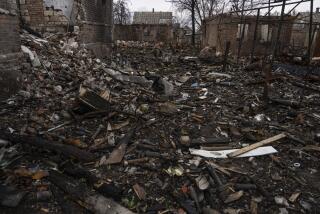Book Review : Stalin: The Moral Dilemma of His Undeniable Achievement
- Share via
Stalin and the Shaping of the Soviet Union by Alex de Jonge (Morrow: $23)
The apparent madness of tyrants still poses vexing questions for students of Russia’s past. Was Ivan the Terrible’s reign of terror in the 16th Century the work of a madman, or did a rational policy underlie what so many historians have portrayed as the czar’s unbridled passion for torturing and killing his subjects? Was Peter the Great driven by a capricious hatred of things Russian? Or was his ruthless destruction of Old Russia part of a rationally conceived policy calculated to force his backward nation into the modern world?
The intervening centuries have muted our sense of the terror that filled those long-ago times. Although cursed by their contemporaries as madmen or antichrists, both Ivan and Peter now have emerged as far-seeing champions of a greater, more powerful Russia who struggled to strengthen their nation against the military and economic onslaughts of Europeans.
Similar questions arise with Stalin. When he came to power in 1927, the young Soviet state was struggling to recover from the ravages of World War I, a civil war and the famine that followed. At his death a quarter of a century later, the Soviet Union stood out among the proud conquerors of Nazi Germany as one of the world’s two greatest military powers. Stalin’s accomplishment was no less dramatic than that of Ivan the Terrible or Peter the Great, but time has not yet dulled our perception of the terror that accompanied his achievement.
Historians’ Questions
Although Stalin’s achievement is undeniable, its cost remains incalculable and its moral dilemma inescapable. Historians therefore continue to ask: Was Stalin’s quarter-century reign of terror the work of a madman? Or was it a price that backward Russia had to pay in order to become one of the world’s superpowers? Does the end, however desirable from the Russians’ point of view, justify the means that took the lives of millions, and the health and happiness of tens of millions more?
Although Stalin’s terror and accomplishment are not interpreted in the same way, the well-researched biographies by Isaac Deutscher, Robert Tucker and Adam Ulam have lifted much of the veil of mystery that once surrounded the man who has been cursed as history’s most blood-thirsty tyrant and praised as one of the 20th-Century’s greatest statesmen.
Still, these biographies are by no means the last word. Important sources that were not available when these books were written remain unexplored. Western governments continue to declassify diplomatic papers that promise exciting new insights into Stalin’s life and times, and the personal remembrances of key people continue to be published. All of these will require careful study before the final judgment about Stalin’s crimes or achievements can be pronounced.
Superficial Biography
One therefore turns to any new book about Stalin with particular anticipation, which makes Alex de Jonge’s “Stalin and the Shaping of the Soviet Union” all the more disappointing. This awkwardly written volume is at best a superficial and unrevealing biography that draws mainly upon frequently studied and readily available sources.
From De Jonge’s account, we learn very little about Stalin’s life and policies that has not already been told by others with greater accuracy and sensitivity. The book teems with unsupported generalizations and sloppy oversimplifications. “Over the years,” De Jonge tells us, “Stalin would develop creative denunciation to the point that it became the national sport of an entire nation.” Not only is that statement untrue, but it ignores the great moral achievement of those many Russians who certainly did not see denunciations as a “national sport” and struggled to lead honest lives despite the terror of Stalin’s regime. Further, to state flatly, as De Jonge does, that “any Soviet citizen over the age of 70 has certainly bayed for blood in his day and probably been a police informer into the bargain,” distorts the truth to a degree that is bound to appall any fair-minded reader.
One of Stalin’s most striking accomplishments was to shape backward Russia into the Soviet industrial giant. Any study about him therefore must attend seriously the reasons for Russia’s earlier economic backwardness and explain how Stalin overcame them.
De Jonge’s book does not improve our understanding of the complex questions surrounding Stalin, Stalinism, and the process that shaped the Soviet Union between 1927 and 1953. Until someone comes along who is ready and able to examine the new sources that remain unstudied, the thoughtful, more carefully researched biographies by Deutscher, Tucker and Ulam will continue to be the books to read.


